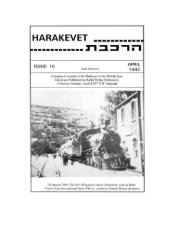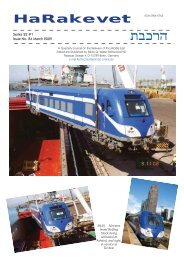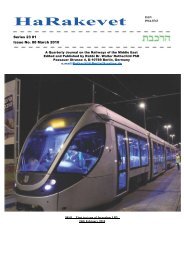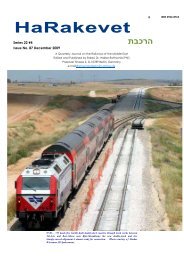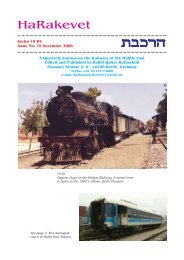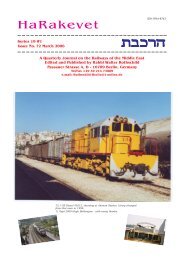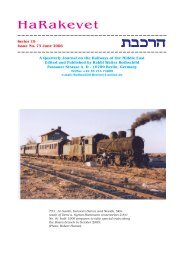Create successful ePaper yourself
Turn your PDF publications into a flip-book with our unique Google optimized e-Paper software.
axle. A pin through the ball drove the outer<br />
axle. The internal diameter of the outer axle<br />
was sufficiently large to allow radial movement<br />
and a subsidiary gadget allowed the<br />
axles to slide longitudinally with respect to<br />
each other. All of this blacksmith’s nightmare<br />
was for the purpose of allowing an eightcoupled<br />
engine to traverse the sharp curves.<br />
Although the first and last pair of drivers had<br />
radial motion these engines were far harder<br />
on the track than the Mallets.<br />
For those who are interested in<br />
the more desolate places in the world there<br />
are the remains of a sixty-centimetre gauge<br />
railroad to be seen at Mersa Fatima, a port<br />
south of Massaua. The port and railroad were<br />
built by the Italians early in the century to tap<br />
a potash deposit some fifty miles from the<br />
coast. The line ended at Kulluli in the midst of<br />
an applling desolation of treeless and waterless<br />
desert. The railroad was killed by the depression<br />
and odd bits of it now lie scattered<br />
on scrapheaps all over Eritrea.<br />
The locomotives of the Ferrovie<br />
Eritrée always face in the same direction, to<br />
keep the crownsheets covered with water<br />
on the steep grade. There are few railroads<br />
in the world that can offer a 7,300 foot<br />
change in altitude in 73 miles - an engineering<br />
achievement of the first magnitude.”<br />
[The text continues with extensive<br />
lists and notes on the motive power, which<br />
we shall not reproduce here.]<br />
(b). In ‘Lok Report’ 4/2010 pp. 52-58 (published<br />
in Berlin) is a beautifully-illustrated and<br />
thoughtful article by Bernd Seiler, “ERITREA<br />
- A RAILWAY BETWEEN THE PAST AND THE<br />
FUTURE” based on a visit in February 2010.<br />
Here it is slightly shortened and translated.<br />
“The line still has no regular traffic,<br />
apart from a Tourist Train that runs according<br />
to demand from Asmara to Nefasit and back.<br />
However, this runs only when enough tourists<br />
are prepared to pay the $50 for a ticket. The<br />
train then comprises a steam locomotive and<br />
one coach. This is wonderful in enabling one<br />
to gaze out of the window at the breathtaking<br />
landscape as it passes, but the railway<br />
enthusiast keen on photography will find this<br />
train not very satisfying. Such a person must<br />
make do with one of the five to ten charter<br />
trains run each year - which of course cost<br />
substantially more than $50.<br />
In the last five years one could<br />
say that a lot has been done. There have indeed<br />
been some changes. The steam loco<br />
440.008 is now operational and can be used<br />
- this is the last one of its type. Some of the<br />
four-wheel coaches have been overhauled<br />
for the Charter Trains (and paid for by participants<br />
in the Far Rails Tours) - and so the time<br />
when Krupp bogie coaches were hauled<br />
by the aged steam locos on the Charters is<br />
now past. But one cannot really see any major<br />
progress. In the workshops work is underway<br />
on the boiler of 442.56, the running<br />
gear stands in the depot. Next to the station<br />
a shed that had been used for years for the<br />
bus workshop is now once more set up for<br />
railway work. This was formerly the carriage<br />
works and should function as such once<br />
again. However, there have not been any<br />
major developments on the railway. A point<br />
has been reached where nothing can move<br />
forward without some massive investment.<br />
But there are some high-flying plans for the<br />
railway and many thouands of dollars have<br />
been spent on foreign experts and consultants<br />
and visits to various countries to inspect<br />
locomotive production. Now one is mainly<br />
waiting for an agreement to extend credit,<br />
and then make a big push.<br />
The Future State Railway of Eritrea.<br />
The Railway has plans for running<br />
timetabled services from Massawa to Asmara.<br />
In 2006 there was a test run with a 40-<br />
foot container on a flat wagon and an oil tank<br />
wagon. Against expectations no problems<br />
were encountered in traversing the tunnels.<br />
Since the two remaining Krupp diesel locos<br />
are renowned for high fuel consumption (one<br />
speaks of 5 litres of Diesel per kilometre!), the<br />
Manager of the railway travelled to visit various<br />
locomotive manufacturers, to investigate<br />
the possibility of the acquisition of new locomotives.<br />
In 2009 Chinese and Rumanian<br />
manufacturers were favoured. Now, following<br />
a trip to China, where representatives of<br />
Pakistan and Cuba were also encountered<br />
(both being countries which have acquired<br />
Chinese locos), the cheap offer from China is<br />
perceived somewhat differently and instead<br />
one is eyeing German engines or Chinese locomotives<br />
whose production has been supervised<br />
by German engineers. Italy is also<br />
being considered seriously.<br />
It is also conceivable that secondhand<br />
locomotives could be acquired and<br />
these would then be overhauled in Western<br />
Europe before being shipped to Eritrea. But<br />
before this is possible, there is a great deal to<br />
do. The organisation is currently known as the<br />
Eritrean Railway Rehabilitation Project. Before<br />
any commercial traffic can be undertaken it<br />
will be necessary to reorganise it into a more<br />
normal form, such as a private company or a<br />
State Railway and register it as such. This formal<br />
move is necessary in order to find international<br />
providers of credit. Should these be<br />
found - which will not be easy in the currrent<br />
disastrous state of many lenders - it is intended<br />
to rebuild the line to Agordat at least as<br />
far as Keren.<br />
At the moment the section Massawa<br />
- Asmara has been reconstructed with<br />
old materials and is operational; however, the<br />
reconstruction was carried out according to<br />
the standards of 1920, with rail profiles similar<br />
to S28 (28kg./metre), and the route is hardly<br />
suitable for regular operation. The axleload<br />
is restricted to 12 tons, the loops are short,<br />
there is absolutely no signalling or safety system.<br />
The old trackbed from Asmara on to<br />
,cfrv<br />
Keren has been cleared for about six kilometres<br />
and track could be laid here - if there<br />
were sufficient track materials available. But<br />
even if several kilometres of plain line could<br />
be laid with the materials currently on hand,<br />
there aren’t any spare sets of points. At the<br />
same time there is concern not to have to<br />
relay the whole line again soon after a major<br />
effort - for the future rail of 50kg/metre<br />
is planned, roughly equivalent to the former<br />
Deutsche Reichsbahn S49 profile.<br />
Future Transport Possibilities.<br />
The desire of the Railway company<br />
to become a ‘proper’ State Railway and to<br />
move large tonnages has not just been taken<br />
out of thin air. Of course, if you observe Eritrea<br />
now, following the plundering by British<br />
soldiers in the Second World War and the<br />
dismantling carried out by the Ethiopian occupation<br />
troops and then the 30-year war of<br />
independence which followed that, you will<br />
seek in vain for any industry. Yes, there are<br />
a few small works, but they do not seem to<br />
need a railway. There is no power station in<br />
the interior which needs deliveries of coal,<br />
there is no chemical or metallurgical industry,<br />
there is no car manufacture. But there is, indeed,<br />
some industry. On the Red Sea there<br />
is a cement factory; these works produce<br />
indeed mainly for export, but the amount -<br />
some 250,000 tons per year - which would<br />
be transported to Asmara and beyond,<br />
would provide a basis also for the railway.<br />
At present the cement works has no rail connection,<br />
but it would only be necessary to<br />
lay a few kilometres from Massawa.<br />
On top of this there is a salt works<br />
on the Red Sea, and this would also be interested<br />
in rail transport for its product. But<br />
these two industries are not the main reason<br />
for the Railway Administration’s planning; It is<br />
all about Gold! A Canadian firm is currently<br />
opening two mines and wishes to transport<br />
ore concentrates from the store heaps to the<br />
harbour at Massawa; The ore contains mainly<br />
Gold, Zinc and Copper. Comparative calculations<br />
indicated a major price advantage for<br />
rail transport, for the road transport is also not<br />
really simple, the topography of the country<br />
has always led to various transport difficulties.<br />
One mine is at Bisha - this is the larger of the<br />
two and will produce a transport volume of<br />
between 500,000 and 1,000,000 tons per<br />
year. However, Bisha lies around 220 kilometres<br />
from Asmara and even 100 kilometres<br />
further than Keren, the point on the railway<br />
that one could rebuild without too excessive<br />
a financial outlay. Even if it were possible to<br />
reach Agordat again, the former end-point of<br />
the line, it would still be necessary to build<br />
40km. of new route. That is to say, there is<br />
a railway alignment further on from Agordat,<br />
but it would not be possible to use this without<br />
some very major new earthworks. So<br />
any project to provide a rail link to his mine<br />
would involve not only a lot of physical effort<br />
Page 25



